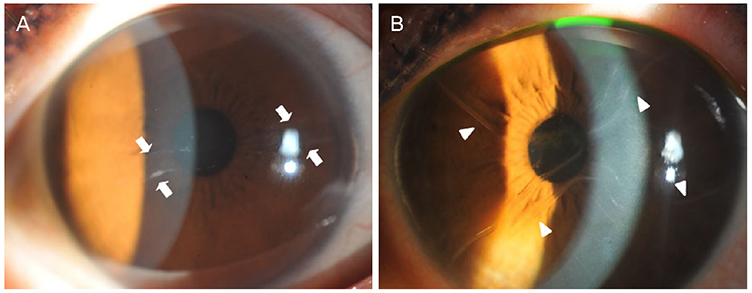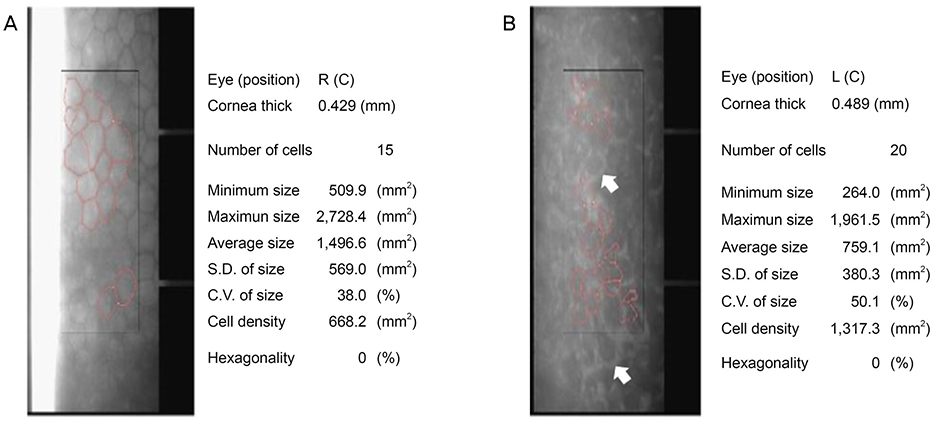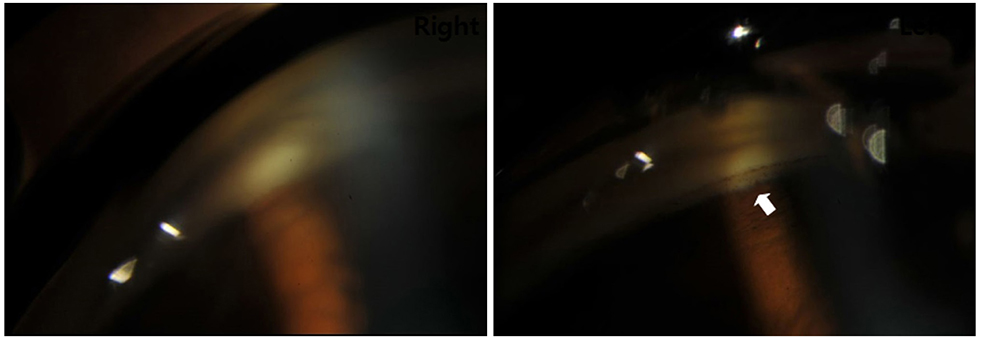J Korean Ophthalmol Soc.
2019 Sep;60(9):909-914. 10.3341/jkos.2019.60.9.909.
Iridocorneal Endothelial Syndrome with Features of Posterior Polymorphous Corneal Dystrophy
- Affiliations
-
- 1Department of Ophthalmology, Haeundae Paik Hospital, Inje University College of Medicine, Busan, Korea. qthoi85@hanmail.net
- KMID: 2459139
- DOI: http://doi.org/10.3341/jkos.2019.60.9.909
Abstract
- PURPOSE
To report a case of iridocorneal endothelial syndrome, which overlapped with some of the features of posterior polymorphous corneal dystrophy.
CASE SUMMARY
A 61-year-old female presented with tearing pain and blurred vision in her left eye, which was aggravated in the morning. The symptom started approximately 1 year prior to her visit. At the initial visit, the visual acuities were 1.0 in both eyes and the intraocular pressures were normal. On slit-lamp examination, a single pair of horizontal parallel lines was observed at the central corneal endothelial layer in the right eye. In contrast, multiple pairs of oblique parallel lines were observed in the left eye. The lines of the lesions were more prominent and wavier in the left eye than those of the right eye. The overlying cornea was clear, and the corneal thicknesses were in the normal range in both eyes. Using a gonioscopic examination, localized peripheral anterior synechiae were observed only in the left eye. The pupil and iris were normal in both eyes. On specular microscopic examination, the corneal endothelial cell size in the right eye increased and the corneal endothelial density decreased to 668 cells/mm². In the left eye, multiple abnormal endothelial cells with dark-light reversal were observed. In conclusion, the patient was subsequently diagnosed with iridocorneal syndrome, rather than posterior polymorphous corneal dystrophy.
CONCLUSIONS
Posterior polymorphous corneal dystrophy and iridocorneal endothelial syndrome may present with many similarities. Therefore, in cases of uncertain diagnosis, an understanding of the clinical features is important for proper diagnosis.
Keyword
MeSH Terms
Figure
Reference
-
1. Feng B, Tang X, Chen H, et al. Unique variations and characteristics of iridocorneal endothelial syndrome in China: a case series of 58 patients. Int Ophthalmol. 2018; 38:2117–2126.
Article2. Sacchetti M, Mantelli F, Marenco M, et al. Diagnosis and management of iridocorneal endothelial syndrome. Biomed Res Int. 2015; 2015:763093.
Article3. Lefebvre V, Sowka JW, Frauens BJ. The clinical spectrum between posterior polymorphous dystrophy and iridocorneal endothelial syndromes. Optometry. 2009; 80:431–436.
Article4. Anderson NJ, Badawi DY, Grossniklaus HE, Stulting RD. Posterior polymorphous membranous dystrophy with overlapping features of iridocorneal endothelial syndrome. Arch Ophthalmol. 2001; 119:624–625.
Article5. Kim NH, Kim MS. The clinical features and progression of the disease in posterior polymorphous corneal dystrophy (PPCD). J Korean Ophthalmol Soc. 2014; 55:368–373.
Article6. Grayson M. The nature of hereditary deep polymorphous dystrophy of the cornea: its association with iris and anterior chamber dygenesis. Trans Am Ophthalmol Soc. 1974; 72:516–559.7. Cibis GW, Tripathi RC. The differential diagnosis of Descemet's tears (Haab's striae) and posterior polymorpous dystrophy bands. A clinicopathologic study. Ophthalmology. 1982; 89:614–620.8. Yanoff M. Iridocorneal endothelial syndrome: unification of a disease spectrum. Surv Ophthalmol. 1979; 24:1–2.
Article9. Wilson MC, Shields MB. A comparison of the clinical variations of the iridocorneal endothelial syndrome. Arch Ophthalmol. 1989; 107:1465–1468.
Article10. Laganowski HC, Kerr Muir MG, Hitchings RA. Glaucoma and the iridocorneal endothelial syndrome. Arch Ophthalmol. 1992; 110:346–350.
Article11. Chiou AG, Kaufman SC, Beuerman RW, et al. Confocal microscopy in the iridocorneal endothelial syndrome. Br J Ophthalmol. 1999; 83:697–702.
Article12. Liskova P, Palos M, Hardcastle AJ, Vincent AL. Further genetic and clinical insights of posterior polymorphous corneal dystrophy 3. JAMA Ophthalmol. 2013; 131:1296–1303.
Article
- Full Text Links
- Actions
-
Cited
- CITED
-
- Close
- Share
- Similar articles
-
- A Case of Posterior Polymorphous Dystrophy
- Confocal Microscopic Findings in Posterior Polymorphous Corneal Dystrophy
- Three Cases of Iridoeorneal Endothelial Syndrome
- The Clinical Features and Progression of the Disease in Posterior Polymorphous Corneal Dystrophy (PPCD)
- Iridocorneal Endothelial Syndrome: iris nevus syndrome





